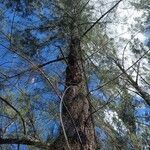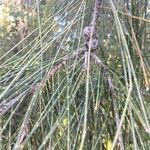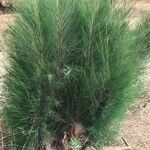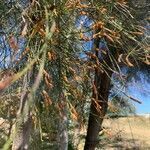Dioecious, small to large tree up to 20 m high, with branches ± erect to somewhat drooping. Young branchlets glabrous or sparsely hairy, fine (c. 0.66 mm diam.), with as many ± flat faces as lf-teeth, the sides faintly ribbed. Lf-teeth of adult branchlets usually 8, sometimes 7 or 9, or up to 11 in immature plants, narrow-triangular, yellowish toward base with a brown band at or above middle, 0.75-1 mm long; tip pale white, later withering. ♂ fls in terminal spikes 5-25-(30) mm long; whorls of bracts overlapping when fls mature. Cone globose to cylindric, rounded to flattened at apex, (5)-8-12 mm long; margins of valves obtuse or acute; seeds dull, pale whitish brown, 4-5 mm long, with pale membranous wing.
Persistent stems with 7–9 ribs, scale-leaves free to 1–2.5 mm., 0.3–0.4 mm. wide, reflexed. Deciduous branchlets 0.4–0.6 mm. diameter, with 7–9 close-set inconspicuous ribs; free part of scale-leaves 0.3–0.5(–0.6) mm. long, 0.1–0.2 mm. wide, straw-coloured with distinct dark red-brown band around united region or in apical half. ♂ inflorescence 1–1.5 mm. in diameter, whorls of bracts close-set, flowers 6–8 per whorl, bracts coloured as scale-leaves. Infructescence 8–12 mm. long, 7–10 mm. wide, ovoid; cells 6–9 per whorl, separated by small gap of ± 0.7 mm.; valve-backs with several irregularly ± longitudinal fine wrinkles; apical 2–3 mm. of valves free; samaras pale fawnish brown.. Fig. 1/1.
Tree 15-35 m high. Bark finely fissured and scaly, grey-brown. Teeth on new shoots erect. Branchlets drooping in vigorous specimens, erect in depauperate specimens; articles 4-9 mm long, 0.4-0.7 mm diam., mostly glabrous; edges of furrows often marked (when dry) by a slight ridge; phyllichnia angular to flat with a median rib; teeth 6-10, erect, 0.3-0.5 mm long, marcescent or not. Male spikes 0.4-4 cm long, 11-13 whorls per cm; anther 0.4-0.7 mm long. Cones sparsely pubescent; peduncle 2-9 mm long; cone body 7-14 mm long, 4-6 mm diam.; bracteoles broadly acute to acute. Samara 3-4 mm long.
Trees dioecious, to 25(-35) m tall, often with suckers from roots. Trunk straight, to ca. 40 cm d.b.h.; crown pyramidal; bark finely fissured and scaly, gray, adaxially pale red. Ultimate branchlets spreading to slightly pendulous, dark green, grayish green, or glaucous-green when dry, 15-38 cm × 0.5-0.7 mm; articles 4-5 mm. Leaves erect, 8(-10) per whorl, narrowly lanceolate. Male spikes 1.2-2(-4) cm. Cones ellipsoid or subglobose, 7-12 mm, truncate at both ends; apex of bracteoles acute. Samaras 3-5 mm including wing. Fl. Apr, fr. Jun-Sep. 2n = 18*.
A tall spreading tree. It grows 10-30 m high. It spreads 5-15 m across. The branches tend to droop. The leaves are reduced to rings or 8-10 tiny sharp leaf-teeth at the nodes of the stems. They are dark green. Trees are separately male and female. Male flowers are short and reddish brown spikes 3-4 cm long at the end of branches. Female flowers are red and round. They occur on mature wood. The fruit are cones which are round, grey and 1 cm across. They have sharp points on them. Plants are wind pollinated.
Deciduous branchlets 0.4–0.6 mm. in diam., with 7–9 inconspicuous ribs; scale leaves with a distinct dark red-brown band, free pan 0.3–0.5(0.6) x 0.1–0.2 mm.
Infructescences 8–12 x 7–10 mm., ovoid; valves with several irregular longitudinal fine wrinkles.
Persistent branches with 7–9 ribs; free parts of scale leaves 1–2.5 mm. long, reflexed.
Male inflorescence 1–1.5 mm. in diam.; bracts appressed, flowers 6–8 per whorl.
Subspecies 2 (1 in the flora): North America; native to ne, e Australia.
Samaras pale brown, dull.
Tree.












